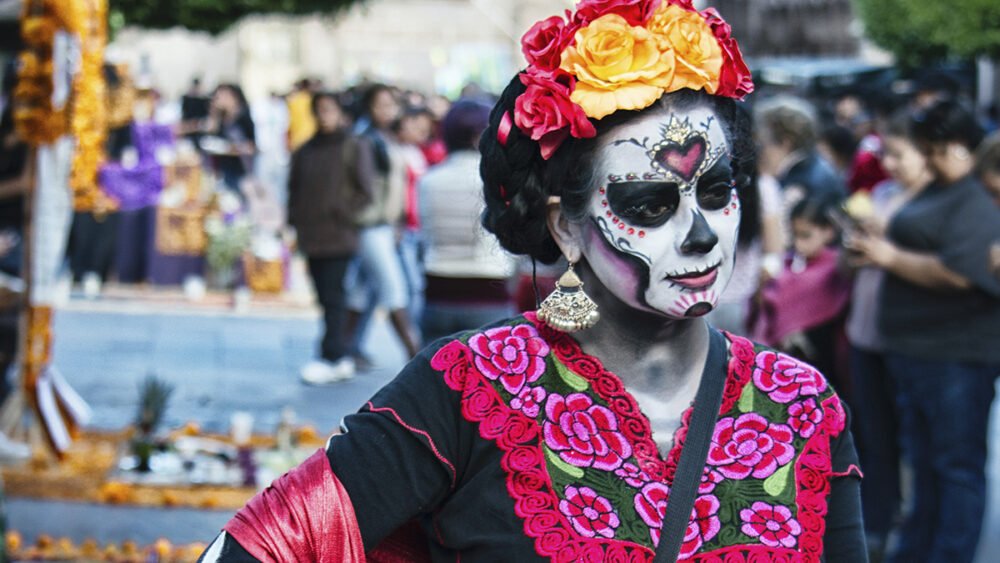Dia de Muertos: A Celebration of Culture, History, and Family

Dia de Muertos, or Day of the Dead, is an annually celebrated Mexican holiday that begins on November 1st and ends the following day. It is a lively and vibrant celebration that honours both life and death. It is a holiday that brings families together as a celebration of each other, and a remembrance of loved ones that have passed on.
It is believed that at midnight on October 31st, the gates of heaven are opened, allowing the spirits of loved ones to come to the land of the living for 24 hours. November 1st is known as el Dia de los Inocentes, or the day of the children. It is said that on this day, children who have passed come back to visit and celebrate with their families as angelitos (little angels). On November 2nd, adults who have passed come back to join in the festivities with their families.
The Day of the Dead is a blend of Aztec culture with a Catholic influence that was brought to Mexico by the Spaniards in the 16th century. The original Aztec celebration was a festival that honoured Mictecacihuatl, the Goddess of Death. The Aztecs did not fear death, and viewed it as an inevitable part of the circle of life that should be celebrated. The Catholic church did not approve of the Aztec beliefs and celebrations, and ultimately combined their two belief systems and turned the holiday into All Saints’ Day. Since then, the Mexican people have reclaimed the holiday and transformed it into something of their own.
Day of the Dead is a special holiday in which the living and the dead can come together and celebrate as one. For an event this extraordinary, it’s no such wonder large festivals and celebrations take place. This is not a day meant for sadness and mourning; it is for the celebration of life and of those who are no longer with us.
This holiday is celebrated with a variety of different traditions. One of the most recognizable is the calaveras, or skulls. In Aztec culture, skulls were used during rituals and as trophies during battle. Now, sugar skulls are colourfully decorated and placed on altars to honour the dead. These altars are known as ofrendas, which means “offering” in Spanish.
Ofrendas are carefully and beautifully decorated to honour family members who have passed. Every ofrenda must contain the four elements: water, wind, earth, and fire. Pictures, candles, food, drinks, items that once belonged to those being honoured, and Marigolds are often what are used to help the spirits on their long journey from heaven to earth. Wind is represented by colourful paper banners called papel picado.
Marigolds are typically the flower of choice, as one type of them, the cempasúchil, is native to Mexico. They are thought to have the power to guide spirits back home with their vibrant colours and strong smells.
Disney’s Coco (2017) is a beautiful movie that focuses on family and The Day of the Dead, and gives viewers a closer look at the celebration and Mexican culture. I would highly recommend that you watch it if you have not yet (disclaimer: this movie will make you cry – don’t say I didn’t warn you).
Typically, this holiday is celebrated with family gatherings, large parades, and festivals. However, things will be different this year with COVID-19. In-person gatherings have mainly been cancelled, and moved online. Community altar viewings, performances, movie screenings, and art showings will be held via Zoom.
The Day of the Dead is a beautiful holiday with a fascinating history. It is beneficial to both those who celebrate it and those who do not to take a look at different cultures and how they view the circle of life. It is somewhat refreshing to take a look at this holiday to see how it both celebrates life and honours the dead in such a lively way. It is unfortunate that in-person gatherings could not be held this year, but exciting to see how they will fare over Zoom.
More like this:
- The Mythology of Samhain
- 13 Seriously Spooky Stories to Read this Halloween
- 10 iconic Halloween movies
Sources:
Anderson, Maria. “5 Facts About Día De Los Muertos (The Day of the Dead).” Smithsonian Institution, 2016, www.si.edu/blog/5-facts-about-dia-de-los-muertos-day-dead.
“The History of Day of the Dead.” Day of the Dead, dayofthedead.holiday/history/.
History.com Editors. “Day of the Dead (Día De Los Muertos).” History.com, A&E
Television Networks, 30 Oct. 2018, www.history.com/topics/halloween/day-of-the-dead.
Ziemba in Arts & Entertainment on October 26, Christine N. “You Can Still Celebrate Día De Los Muertos During The Pandemic.” LAist, 2020, laist.com/2020/10/26/where_to_celebrate_dia_de_los_muertos_events_during_pandemic_2020.php.